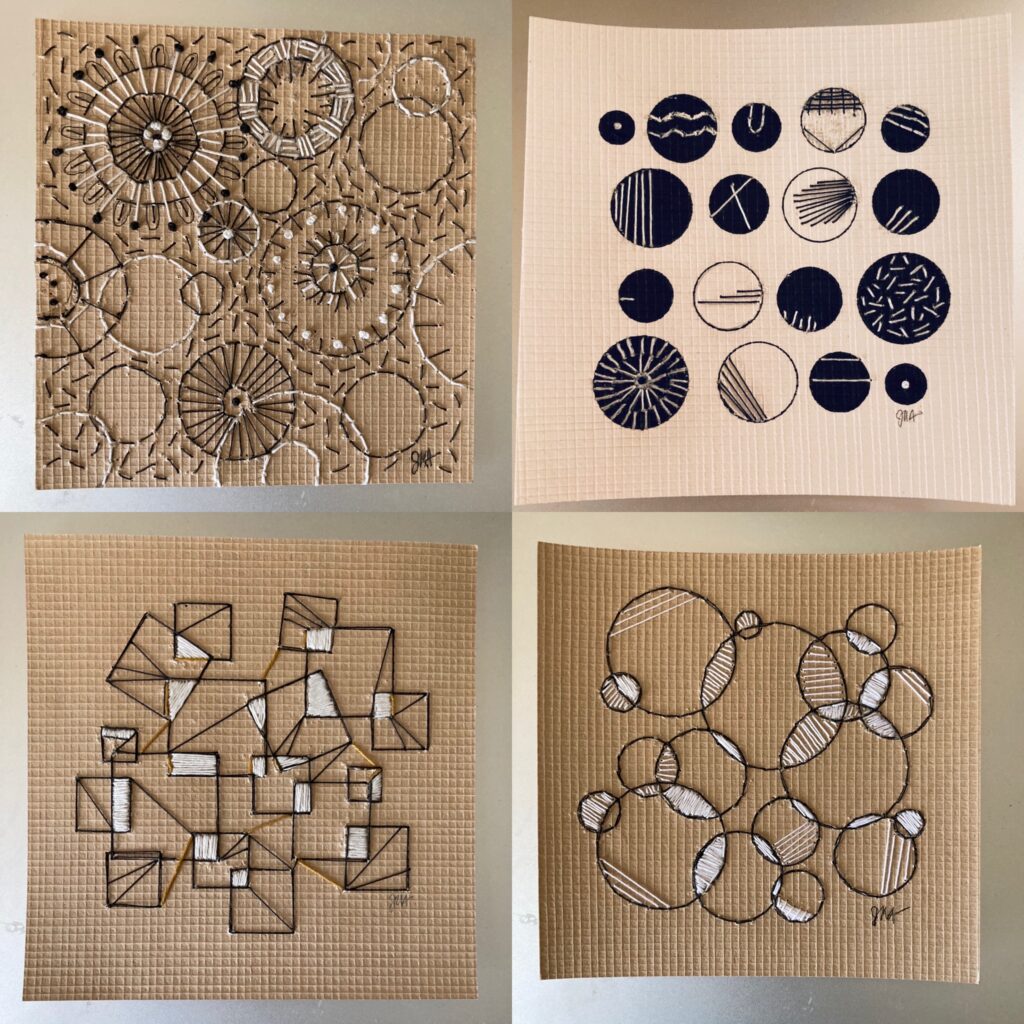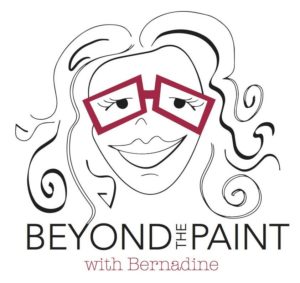Explore textiles in the visual expression through the practice of contemporary artist Jean Rill-Alberto. Her Stitch Meditation series are small, intimate pieces, surfaced textured of geometric and organic shapes and forms. Creating with textiles and paper, the act of stitching became a kind of therapy for the artist, especially during the pandemic. This episode includes a conversation with the artist.

Other artists highlighted and celebrated in this episode include :
April Dauscha, “Custody of the Tongue (veiling), 2013
Resources for this podcast episode include: Jean Rill-Alberto website, April Dauscha website, writer Sara Barnes, historian Saisha Grayson-Knoth and Brooklyn Museum of Art
Judy Chicago, “The Dinner Party,” 1979 Hatshepsut Place Setting


Featured on this episode is The Red Barn Art Center in Durham, Connecticut. Learn more about classes and other creative offering >>>> Red Barn Art Center
SCRIPT: Today we will explore Fiber arts, in part, as an arts movement, focusing on the role feminist artists played in elevating textiles to high art through one or two works. Layered in this episode we will also experience fibers (textiles) through the contemporary artist Jean Rill-Alberto and her series that combine textiles and the act of meditation. This episode includes a conversation with the artist for her insight into the creative hands of fiber art. So stay tuned for that!
There is a deep and long history in textiles in art–it is both a new and old form of art. “Traditionally fibrous materials emerged as functional objects; practical purposes such as clothing, blankets to keep warm; the Industrial Revolution was a turning point for textiles with the invention of the cotton gin, power loom that created fabric on a massive scale; textiles were cheaper and available to more of society including creative people who could experiment with them in previously unseen ways. It wasn’t until the aftermath of World War II and with further investigation into the nature of an art object, fiber art slowly became a force in its own right. During the 1950s, as various artists-craftsmen received recognition, the term fiber art was coined to help describe their work. During this period a number of weavers began binding fibers into non-functional and non-objective forms as works of art. It was in the 60s and 70s that brought an international revolution in fiber art. With the rise of the women’s movement and subsequent feminist art movement, fiber art, works consisting of natural or artificial fibers, from hand-woven works to industrially produced fabrics, was reinforced and elevated to fine art.
Let me take a step back and further define the role of women in this historical perspective in fiber arts; important to note that the history I am unrolling for you is centered in the United States where the feminist art movement forms through the 60’s and 70’s. The Feminist art movement is the intersection of Feminism and Art. From the art historian Saisha Grayson-Knoth “This intersection produces may interesting effects, disrupting the story of art; particularly Modernist and its smooth transitions from one “important style” to the next (Fauvism, Expressionism, Futurism)–in essence it disrupts patriarchy within that story and challenges the art world and its institutional bias, making space for women to make and show art of all kinds; serving as a critical lens for considering all cultural production in relation to gender.
Here I gave you a brief, very brief big picture view of fiber arts history–including a little bit of the historical perspective of women artists through the feminist art movement. This is in this pool where we will wade–in regards to the medium fiber or textiles, experiencing fiber materials and the manual labor on the part of the artist where aesthetic value over utility is prioritized by women.
The dominant figure, the pioneering figure is artist Judy Chicago. She “reintroduces textile and fiber, generally seen as “women’s work” into high art. Typically considered “woman’s job of leisure or skill,” like knitting or weaving or needlework, Chicago used the medium to “subvert its history as women’s work and transform it into colorful, fun and sexually liberated works.” Alongside other female artists she worked on projects like the iconic installation “The Dinner Party” in which she created ceramics and textiles (the table runner for example)for each place setting. (I presented The Dinner Party in episode 96 and my celebration of contemporary artist Sally Brown; I encourage you to check that episode out for a deeper dive into that installation.)
Techniques in Textile Art include weaving, where threads are laced together on a loom at intersecting angles to form cloth; embroidery, in which artists use thread to stitch decorative designs onto fabric, knitting and crocheting in which needles are used to twist thread into different stitches which in turn create larger patterns. While many textile artists use traditional techniques as a starting point for their work, other artists deconstruct these established practices. (Sara Barnes)
Contemporary Textile or Fiber artists showcase the vast possibilities when dealing with fabric, thread and yarn. One female artist I want to celebrate with you is April Dauscha. She “wraps her tongue, her mouth, or her eyes in delicate lace works. ” Each intricate piece of lace is handmade by Dauscha in a “repetitive process of stitching” that can take as long as 12 hours at a time. In the photograph (2013) titled “Custody of the Tongue (veiling)”, we see a portrait of a white woman’s face, only her mouth, chin and bare neck are revealed, hair, brown is tied back, some wisps of hair float against the white background. Her mouth is open, pink tongue sticks out, the tip meets the crest of her chin. It is covered in a fitted lace cloth; a drop of saliva hangs from the tip of her pink tongue, at the bound edge of the lace cloth. Dauscha “investigates the ideas of morality, mourning and mortification using the human body–wrapping her tongue, mouth or eyes in delicate lace works she explores topics such as transformation, reconciliation and communication through dress” She states, “My making focuses on feminine objects and materials. Lace, veils, undergarments and hair adornment speak not only of womanhood, but also of the duality of human nature. Lace speaks of purity and sexuality; it reveals and conceals, it is humble yet gluttonous in its ornamental overindulgence; I use it as a potent symbol to represent the duality of body and soul, right and wrong, good and evil. ” For her pieces like Custody of the Tongue, the artist also performs the act of fitting or covering her tongue into the lace cloth. (I will add a link to my website where I uploaded a video of her performative work so you can experience this first hand.)
I include Dauscha to illustrate feminism by a contemporary woman, a book end to the pioneer of feminism in art, Judy Chicago–whose work intersects feminism, womanhood and embedded associations with the decorative work lace. For me personally, the wrapped tongue, and it notable that everyone brings their personal experiences and their biases when they step into that space between themselves and a work of art. What I bring to the looking experience is being raised in a traditional Italian-American, Catholic family, the lace the surface beauty, wrapping your tongue, for me, the material, the delicateness of it, muffles the voice, muffles the expectations of the role women should embrace anchored in patriarchal rhetoric.
One of aspects of textile arts that interests me is the process of the work. As you know, I am not a maker and honestly do not have the desire or patience to make from threads a larger work. Dauscha claims she works upwards of twelve hours to make her lace piece. The contemporary artist Jean Rill-Alberto weaves stitches onto woven paper through her pieces, and they are small, intimate pieces, 6×6 inches in her series “Stitch Meditation.” In the square shaped woven paper she explores shape, pattern and form, both geometric and organic shapes and forms, creating eye-pleasing, harmonious designs. I am drawn to the more modernist compositions. She says, “This past year was a time to try to stay balanced and calm amidst all the chaos and the loss of so many lives. Some pray, some meditate daily or practice Buddhism. I do stitch meditations as my therapy. These paper stitch meditations were my way of coping. I stitch on paper because the feel and sound of poking and running the needle through the paper is a very comforting experience and it became a constant source of tranquility for me. I draw my design on paper with pencil and then using sashiko threads, I stitch my designs.”
